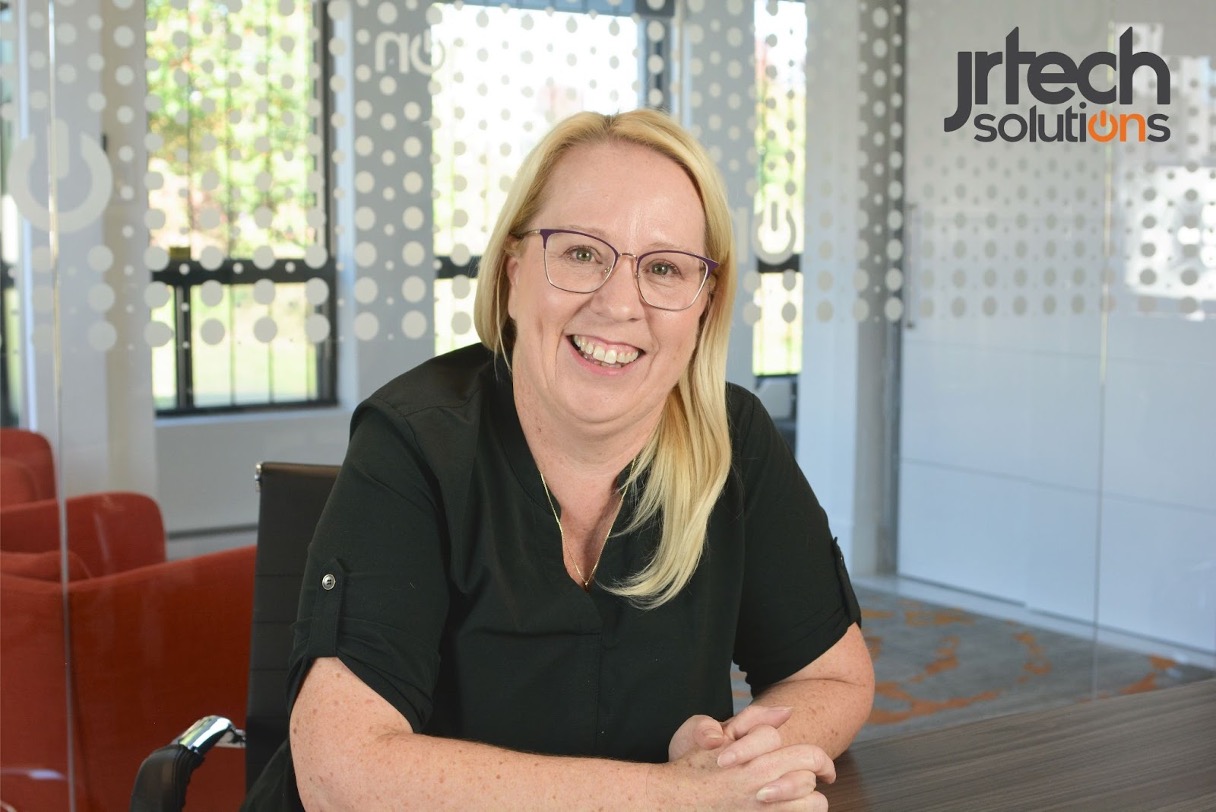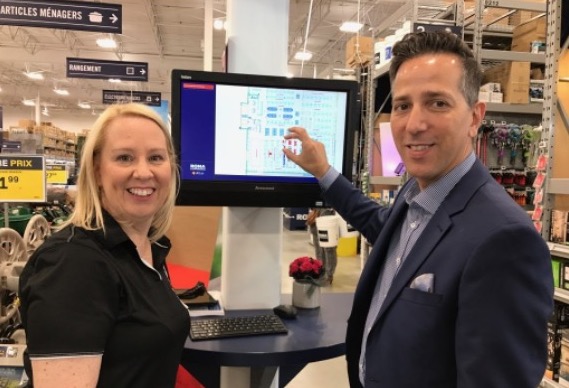
Liette Hogue – Former manager of three RONA stores of L’Espérance Renovation Center Group is one of the few retailers to have experienced in her stores, the installation of two electronic shelf labels systems: the radio-frequency then, the infrared communication.
In fact, Liette Hogue installed her first hardware store with electronic shelf labels (ESLs) using a radio-frequency communication system. At some point, her employees and herself started facing some technical issues such as : lack of communication between the ESLs and the back-office, struggles to update prices rapidly, dead zones in some areas of her store and the short battery life of the ESLs.
When discovering JRTech’s infrared electronic shelf labels from Pricer, she directly noticed the differences between both communication systems and decided to install her stores with Pricer’s ESLs. All the issues she was previously facing in her store operations have now disappeared. In addition to deploying Pricer’s infrared ESLs, Liette Hogue has also adopted JRTech Solutions’ services such as Put-to-light for quick replenishment and Geolocation for better customer service.
We sat down with Liette Hogue so she could tell us more about her experience with the radio-frequency communication system and why she switched to the infrared system only offered by Pricer with JRTech Solutions.
L: Hello, my name is Liette Hogue. I was a member of the board of Groupe L’Espérance of L’Espérance renovation center which owned three RONA stores a few years ago. I was the manager of these three stores.
Q: Tell us about your experience with your previous automated pricing system before meeting JRTech Solutions.
L: We installed the first system when we opened the Blainville store, which was a new store. So we tested that first system in that location and we kept it for about five years if I remember correctly.
After that, we started to experience situations that we didn’t like and we started to hear about JRTech. And that’s when we reviewed the technology differences between what we had in our store and

what was now available in the market. It’s when we were about to open a new store that we thought it was time to compare technologies and ask ourselves if we had the right system.
Q: What type of electronic shelf label system did you have and what were the consequences ?
L: The first system we had used radio-frequency communication. Two of the main problems we had with this system were the fact that we didn’t have any information coming back from the electronic shelf labels so if we sent information to the electronic label and the label didn’t receive it (because of the dead zones present in the store, which were parts of the store where the signal didn’t always communicate properly with the electronic shelf labels). So, we weren’t informed and that caused us problems.The prices didn’t change and we didn’t know about it.
The other problem we had was that it took an excessive amount of time to do updates because when we did them, the system updated all the electronic shelf labels, even those that hadn’t changed price. This forced us to make updates only at night, so we could not make price changes during the day, and one of the objectives of electronic shelf labels is to make price changes quickly and to recover the money
or the investments quickly, which we could not do with these labels. We absolutely had to do the updates at night and sometimes in the morning the updates were not finished.
Q: What were the issues with the radio-frequency system in terms of communicating with your labels?
L: It happened that in the morning when we arrived at the store, the update had not taken place during the night for many reasons and problems. And if that happened, it would take us all day long to do the update, so we would end up with prices that were not up to date all day.
If we were on a day of promotion price change for example, or circular price change, the updates weren’t done and this caused problems with the customers. We were managing stores that had 20,000 to 22,000 labels installed, which was a major problem. It was causing us to give discounts to customers during the day because the prices were wrong or put up signs that said “labels out-of-service, sorry the prices may be different at the register!”. So that was one of the problems we were experiencing because of the update that was taking way too long.
Q : Why did you decide to change your radio-frequency system for Pricer’s infrared communication electronic labels from JRTech Solutions?
L: When we were approached by JRTech to install PRICER’s infrared electronic shelf labels, I wasn’t open to the discussion. I couldn’t believe that there was such a big difference between the infrared electronic shelf labels and the radio frequency labels that we had at the time. It was through perseverance that they finally convinced us to listen to them, and that’s when we understood that if we had PRICER’s infrared electronic shelf labels, there would be a bidirectionality between the electronic shelf labels and our system that would allow us to know if there were issues with our prices, with our displays, if our labels were dying, if they didn’t receive the right price. All this information wasn’t available with the radio-frequency label system.
Q: What made you decide to change your radio-frequency electronic shelf label system for Pricer?
L: At the time we were approached by JRTech for PRICER’s electronic shelf labels, we had over 3,000 dead labels. The batteries were at the end of their life so we had to start investing in batteries and we had reason to believe that we were going to have this problem with many more labels, knowing that we had 21,000 labels to manage in the store at that time, and we already had over 3,000 that were dead. So we needed to make that change.
Q: What were the benefits of adopting Pricer’s infrared electronic label system from JRTech Solutions for your stores?

L: When we opened our new store in Blainville, we decided to go with PRICER’s electronic shelf labels with JRTech Solutions and that’s when we saw the big advantages of the infrared system. When it came to price changes, we could do it during the day without any problem and quickly.
The update was done only on the labels concerned and not on all the electronic shelf labels. If there was a problem with a label that wasn’t receiving the information, we were aware of it. But in any case there was no problem. We had antennas installed all over the store and there were no dead zones in this store, unlike the old technology where we had a lot of dead zones in our other store.
In fact, we ended up changing our other store a few months after installing the infrared labels at the new store. We had removed all
the RF labels systems in our first store and replaced them with the new ones from JRTech Solutions and we didn’t have any more dead zones at that point. These new electronic shelf labels allowed us to have a nice interactive kiosk at the entrance where customers could search for products and the kiosk would tell them where the product was in the store. Even our employees who were looking for products would sometimes go to the interactive kiosk, type in the description of the product and then say : “Oh yeah, it’s in this row, we moved it”.
When we placed our merchandise, we could use our mobile barcode scanner to flash the labels to see which products we had in stock. It’s really handy on products that look the same, like little screws or screw boxes that all look the same but have their own little characteristics.
Q: Tell us more about how Pricer’s infrared communication system provided new opportunities in managing your operations.
L: After installing PRICER’s electronic shelf labels with JRTech Solutions, we started to go further and look for other benefits with these electronic shelf labels, including replenishment.
When we placed our merchandise, we could use our scan gun to scan the product and the electronic shelf labels would start to flash. So we were sure to put the product in the right place. It sounds simple, but when we place little screws, for example, all the packages look the same, so when the electronic shelf labels flashes, we are sure that we are placing the product in the right place.
Another advantage of PRICER’s electronic shelf labels is the Geopositioning. This is something that we implemented fairly quickly after the store opened, which allowed our customers with a nice screen at the entrance to write down the description of the product they were looking for and that gave them the information of the position of the product in the store. Our employees even used it from time to time when they were looking for a product. They would write it down on the screen and then say : “Oh, that’s right, we moved it, it’s now in that spot in the store”. It’s very, very convenient in everyday life.
Q: Have you noticed differences between radio-frequency and infrared communication ?
L: Having lived with both systems, radio frequency and infrared, I know for a fact that there is a big difference between the two systems. The day-to-day bidirectionality allows us to be informed of any problems with our electronic shelf labels. The speed of the updates was like night and day.
Q: If you would have known about Pricer’s infrared system from the start, would you still have chosen a radio-frequency electronic shelf label system?
L: Looking back today, if I had known both technologies at the beginning, would I have made the same decisions? Would we have made the same decisions? I wasn’t alone in the decision process. But personally today, having worked with both technologies, knowing the advantages of JRTech Solutions’ electronic shelf labels, my decision would definitely be to go with infrared today. It’s much more efficient, much more cost effective when you make price changes. Our goal is to be able to make our price change as quickly as possible. And with these electronic shelf labels, everything is easier.
Q: Describe the level of customer service and support from JRTech Solutions.
L: The service we have had with JRTech Solutions has lived up to what was promised. All the promises they made have been delivered whether in the durability of the batteries, the service, the service in Montreal, the service in French, the speed. We always got what we were promised.

